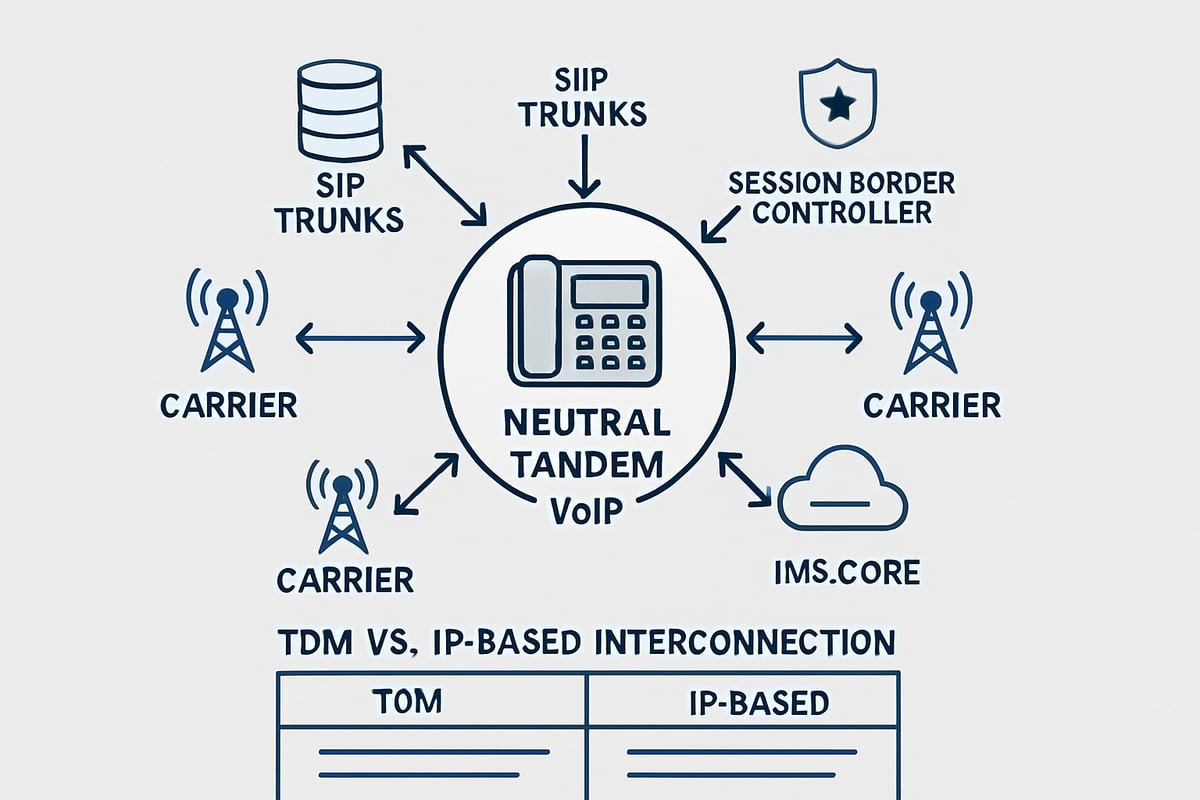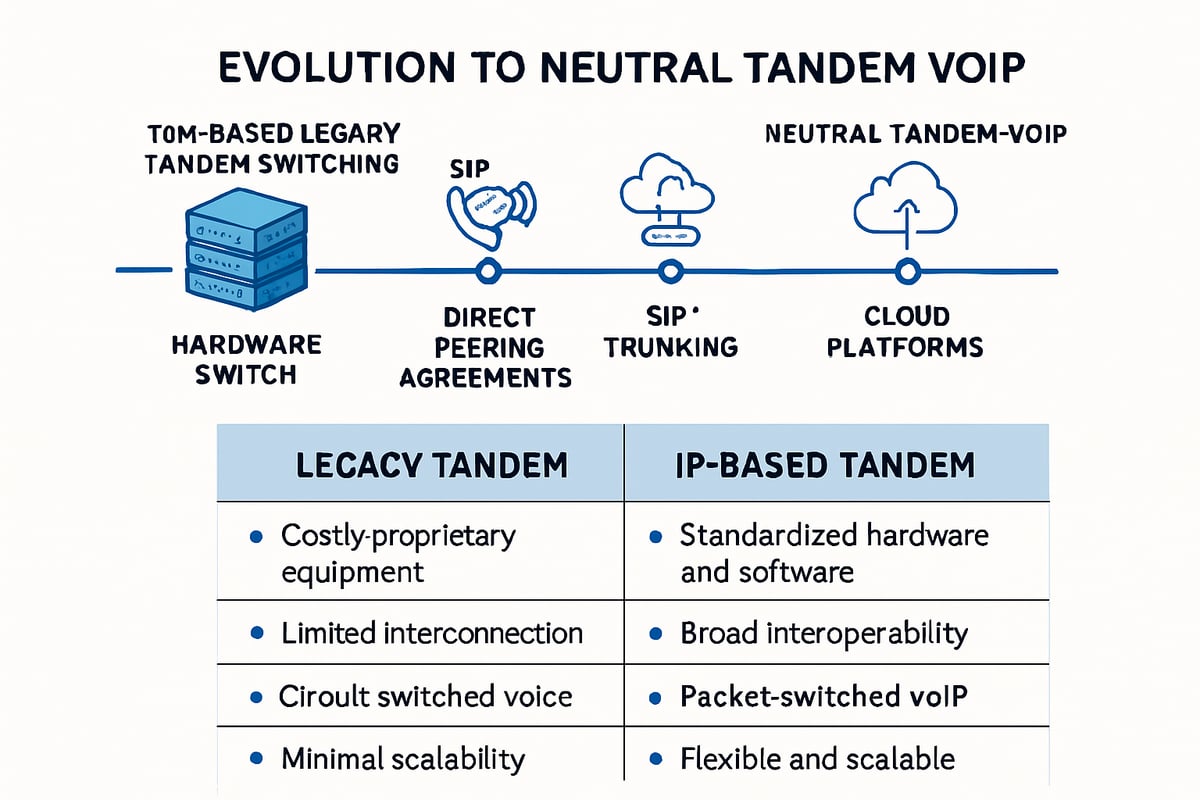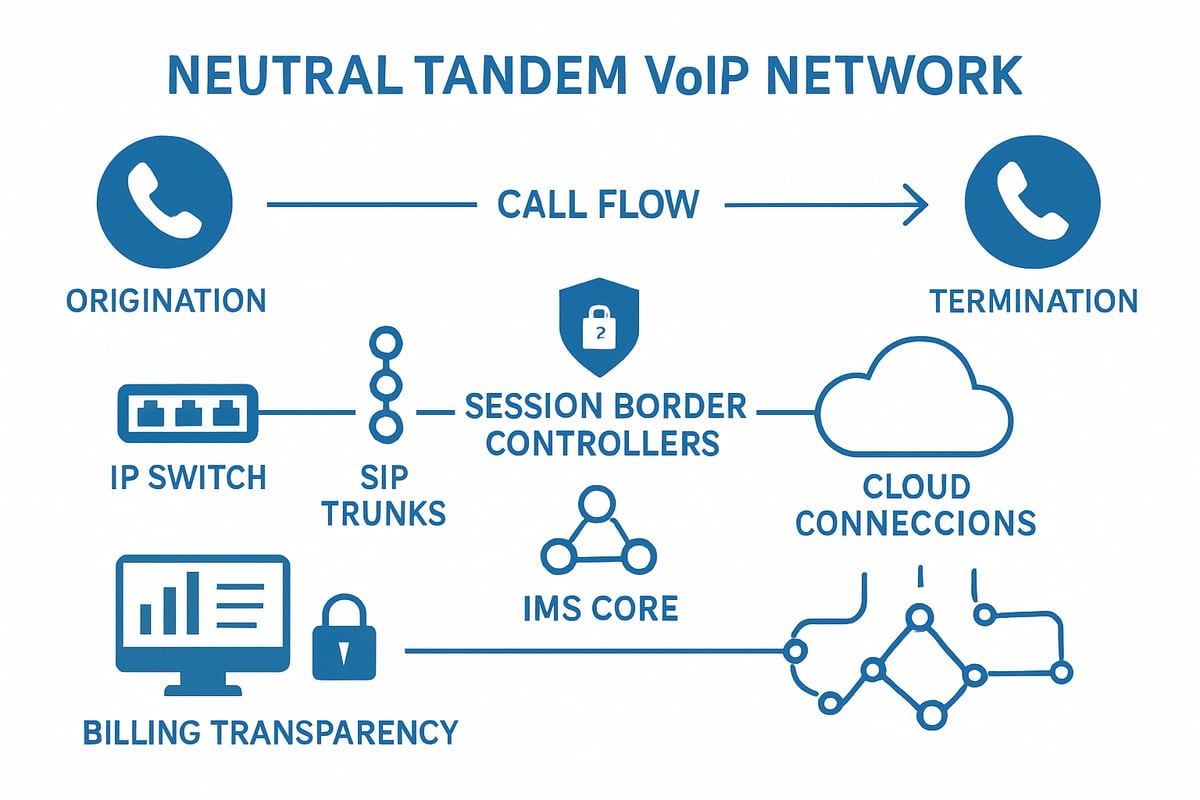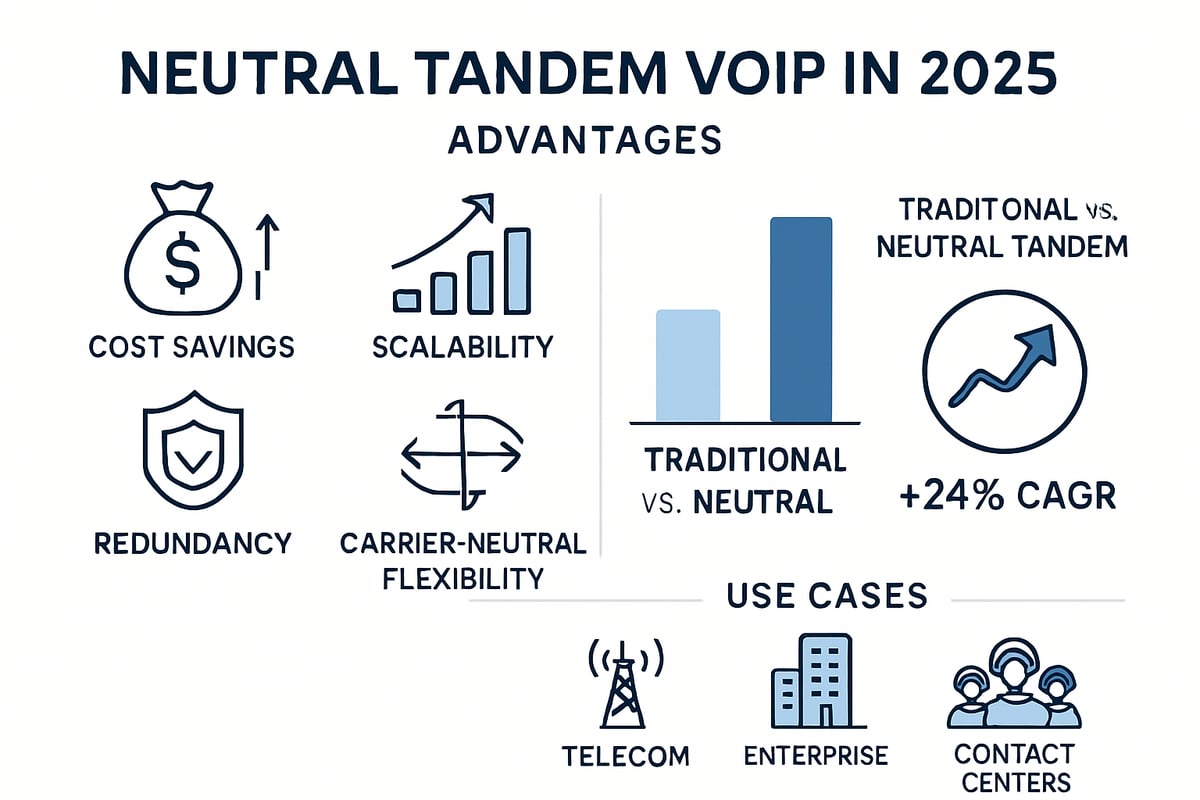Neutral Tandem VoIP Guide: Essential Insights for 2025
Discover the essentials of neutral tandem voip for 2025 Learn key concepts benefits implementation strategies and future trends to optimize your voice network
Redaction
29/09/2025, 12:30:00The rapid growth of IP-based communications is reshaping the telecom landscape as we move into 2025. Seamless interconnection between carriers is now essential for delivering reliable and scalable voice solutions.
This guide to neutral tandem voip unpacks the core concepts, technical workings, and real-world strategies needed to navigate the evolving voice ecosystem.
You will discover how neutral tandem voip enables efficient, cost-effective interconnection, powers next-generation telecom services, and supports business continuity. Ready to future-proof your communications? Dive in for actionable insights and best practices.
Understanding Neutral Tandem VoIP: Fundamentals and Key Concepts
Neutral tandem voip has emerged as a cornerstone technology in the evolution of carrier interconnection. Unlike traditional tandem switching, which relied heavily on hardware and proprietary systems, neutral tandem voip leverages IP-based protocols to connect multiple carriers and platforms. This approach eliminates the need for each carrier to establish direct links with every other provider, streamlining the entire process and reducing complexity for all parties.

What Is Neutral Tandem VoIP?
At its core, neutral tandem voip is a service and architecture enabling voice traffic exchange between multiple telecom carriers, VoIP providers, and enterprises without requiring direct bilateral agreements. The "neutral" aspect means the provider does not favor or prioritize any specific network or carrier, ensuring fair and open access. This neutrality is crucial, as it fosters competition, interoperability, and rapid scaling in the modern telecom environment.
Traditional tandem switching was based on TDM (Time Division Multiplexing) technology and required expensive, hardware-centric infrastructure. In contrast, neutral tandem voip uses software-driven, IP-based switching that supports both legacy PSTN and modern VoIP services. This distinction allows telecom networks to move away from rigid, siloed architectures toward more agile and scalable models.
Why Carrier-Neutral Interconnection Matters
Carrier-neutral interconnection is the foundation of the neutral tandem voip model. In today's telecom landscape, enterprises and service providers demand flexibility, redundancy, and the ability to adapt quickly to changing traffic patterns. Neutrality removes the barriers of vendor lock-in and complicated peering arrangements, letting participants connect to a single hub and reach all other networks seamlessly.
Neutral tandem voip providers act as impartial digital crossroads, ensuring that no single carrier can dominate or restrict access. This approach enables more resilient voice services, better quality, and cost-effective scaling. For professionals seeking deeper perspectives on trends in carrier interconnection and the evolution of neutrality, the VoIPStore Blog: Industry Insights offers valuable analysis and updates.
Key Concepts and Architecture
Several technical terms are central to understanding neutral tandem voip:
- SIP Interconnect: The use of the Session Initiation Protocol (SIP) for establishing, managing, and terminating voice sessions between networks.
- IP Multimedia Subsystem (IMS): An architectural framework supporting multimedia services, including voice, over IP networks.
- TDM vs. IP: TDM is circuit-switched and hardware-based, while IP is packet-switched and software-driven, allowing for more efficient routing and scalability.
- Session Border Controllers (SBCs): Devices that secure and manage SIP signaling and media streams at the network edge.
By integrating these components, neutral tandem voip platforms simplify network topology. Instead of maintaining dozens of direct interconnections and individual peering agreements, carriers and enterprises connect once to the neutral tandem, gaining access to a broad ecosystem.
How Neutral Tandem VoIP Enables Flexible Routing
A key advantage of neutral tandem voip lies in its ability to support SIP trunking and IP-to-IP peering. SIP trunking provides a virtualized, scalable way to route voice traffic between different networks, including the PSTN and VoIP domains. IP-to-IP peering allows for direct, efficient call exchanges without requiring conversion to legacy formats.
For example, consider a scenario where Carrier A wants to send a call to Carrier B. Without neutral tandem voip, both would need a direct agreement and technical integration. With a neutral tandem provider, Carrier A sends the call to the neutral hub, which then routes it to Carrier B, handling protocol conversions and security transparently.
This model reduces operational overhead, accelerates provisioning, and ensures calls are delivered with high quality and minimal latency.
The Digital Crossroads: Impact and Outlook
By 2025, the majority of carrier-grade voice interconnections in North America are expected to be IP-based, reflecting the accelerating shift away from legacy systems. Neutral tandem voip stands at the center of this transformation, enabling rapid innovation, interoperability, and digital transformation for carriers and enterprises alike.
As the telecom industry continues to evolve, neutral tandem voip will remain pivotal for supporting new business models, cloud-based services, and unified communications. Its neutral, scalable architecture ensures that voice networks can adapt to future demands while maintaining reliability and performance.
The Evolution from Traditional Tandem Switching to VoIP
The telecom industry has experienced a dramatic shift in how voice traffic is exchanged and routed. Understanding the journey from legacy tandem switching to neutral tandem voip is crucial for telecom professionals preparing for 2025. Let's explore the evolution and its impact.

Legacy Tandem Switching: Origins and Limitations
Traditional tandem switching formed the backbone of voice networks for decades. In legacy telecom, tandem switches routed calls between local exchanges, enabling communication between different carriers and regions. These systems were based on TDM (Time Division Multiplexing) technology, relying on dedicated hardware and circuit-switched infrastructure.
Managing legacy tandem switching required significant capital investment. Equipment rooms filled with racks of hardware, specialized cabling, and proprietary systems were the norm. Maintenance, upgrades, and scaling capacity meant additional costs and physical limitations.
Direct peering agreements between carriers were complex and time-consuming to negotiate. Each new interconnection required both technical and contractual arrangements, slowing down expansion and limiting flexibility. If a wireline carrier needed to exchange traffic with a wireless provider, the call would traverse multiple tandem switches, often incurring additional costs and introducing potential points of failure.
A key limitation of legacy tandem switching was its lack of scalability. Adding new routes or increasing capacity required physical changes, sometimes taking weeks or months. According to industry data, legacy tandem switching centers demanded high upfront expenditures but offered little adaptability compared to modern solutions.
In this context, neutral tandem voip represents a major leap forward, addressing these legacy challenges and paving the way for efficient, scalable voice interconnection.
The Shift to IP-Based Tandem Services
The introduction of IP-based voice protocols, such as SIP (Session Initiation Protocol), marked a turning point for telecom networks. With neutral tandem voip, carriers could move away from hardware-centric models and embrace software-defined, virtualized platforms.
IP-native tandem switching leverages cloud resources and software to route calls efficiently. Provisioning new connections or scaling traffic is now a matter of configuration, not cabling. This shift enables dynamic scaling during peak times and rapid response to changing business needs.
Virtualization and software-defined networking have transformed the economics of voice interconnection. Operators can deploy geo-redundant, high-availability platforms that automatically reroute traffic in case of outages, improving service continuity. Advanced routing features, powered by IMS (IP Multimedia Subsystem), support unified communications and cloud PBX deployments.
As more carriers migrate to cloud-based tandem platforms, industry adoption accelerates. According to the VoIP Industry Research Report 2024, the majority of carrier-grade interconnections in North America are projected to be IP-based by 2025. This trend highlights the central role of neutral tandem voip in supporting modern, flexible, and secure voice services.
With these advances, neutral tandem voip is no longer just a technical upgrade, but a strategic enabler for telecom innovation, interoperability, and growth.
How Neutral Tandem VoIP Works: Architecture, Routing, and Billing
Understanding how neutral tandem voip operates is essential for telecom professionals and enterprises seeking robust, future-ready voice infrastructure. The architecture, routing, and billing mechanisms behind neutral tandem voip platforms are designed to maximize interoperability, scalability, and transparency.

Network Architecture and Core Components
At the heart of neutral tandem voip is a modular, high-availability network architecture. This design ensures seamless interoperability between traditional PSTN, VoIP, and mobile networks. The main components include:
- IP Switches: These handle packetized voice traffic, enabling dynamic routing.
- SIP Trunks: Standardized connections that link different carriers and platforms.
- Session Border Controllers (SBCs): Devices that secure the signaling and media streams.
- IP Multimedia Subsystem (IMS) Core: Provides advanced call control, authentication, and service integration.
This structure reduces the need for complex, direct peering agreements between carriers. Instead, neutral tandem voip acts as an independent crossroads, allowing any carrier to interconnect without preference or bias. The result is a simplified network topology, fewer physical interconnects, and faster provisioning.
For organizations evaluating their voice infrastructure, understanding these building blocks is crucial. If you are interested in exploring more about available solutions and their benefits, you can review the VoIP Services Overview for a detailed breakdown of service options.
Call Origination, Termination, and Routing Logic
Neutral tandem voip streamlines the process of connecting calls between disparate networks. The journey begins when a SIP INVITE is sent from the originating carrier. The platform:
- Receives the SIP INVITE and validates the request.
- Queries Local Number Portability (LNP) databases to determine the correct recipient network.
- Applies intelligent routing policies based on traffic patterns, quality, and cost.
- Forwards the call to the terminating carrier or platform.
A practical example: A VoIP provider wants to connect a call to a mobile carrier. Through neutral tandem voip, neither party needs a direct agreement. The platform routes the call efficiently, ensuring high voice quality and minimal latency.
This dynamic routing reduces congestion and optimizes bandwidth usage. It also supports rapid scaling as traffic spikes or new endpoints come online. The flexibility of neutral tandem voip keeps networks agile and responsive to changing business needs.
Billing Models and Transparency
Billing in neutral tandem voip environments has evolved to offer greater clarity and fairness. The two most common models are:
| Billing Model | Description | Use Case |
|---|---|---|
| Per-Call | Charges based on each completed call | Low-volume or variable traffic patterns |
| Flat-Rate | Fixed monthly fee for predefined capacity | High-volume, predictable traffic |
Real-time Call Detail Records (CDRs) are generated for every session, enabling accurate reconciliation and dispute resolution. Transparent billing models empower both carriers and enterprises to forecast costs, manage budgets, and avoid unexpected charges.
For example, a business can quickly identify unusual call patterns or fraud attempts by reviewing their CDRs. Advanced billing systems, a hallmark of neutral tandem voip, also help ensure compliance with internal and regulatory requirements.
Ensuring Security and Regulatory Compliance
Security is paramount in any neutral tandem voip deployment. Session Border Controllers (SBCs) play a central role by protecting SIP signaling and media streams from unauthorized access or interception.
Encryption protocols, such as TLS for signaling and SRTP for media, are standard. These measures safeguard sensitive data and maintain privacy across interconnected networks.
Compliance is equally critical. Neutral tandem voip solutions are designed to meet legal obligations, including CPNI (Customer Proprietary Network Information), CALEA (Communications Assistance for Law Enforcement Act), and lawful intercept mandates.
Regular audits, real-time monitoring, and automated alerts further enhance the security and compliance posture of the network. By following these practices, organizations can trust that their communications infrastructure is both resilient and regulation-ready.
Advantages and Use Cases of Neutral Tandem VoIP in 2025
The rise of neutral tandem voip is transforming modern telecom by delivering efficiency, flexibility, and reliability. In 2025, organizations are prioritizing solutions that streamline interconnection, reduce costs, and support seamless voice traffic across diverse networks.

Key Benefits for Carriers, Operators, and Enterprises
Neutral tandem voip offers a compelling suite of benefits that address the evolving needs of carriers, operators, and enterprises. By leveraging a carrier-neutral platform, organizations can interconnect without direct peering agreements, simplifying network management and expanding market reach.
Core advantages include:
- Cost Savings: Organizations reduce capital and operational expenses by eliminating the need for complex infrastructure and direct inter-carrier arrangements.
- Scalability: Voice capacity can be flexibly scaled to match real-time demand, supporting both rapid growth and seasonal spikes.
- Redundancy and High Availability: Built-in redundancy, geo-redundancy, and diverse routing paths ensure continuous service even during outages.
- Carrier-Neutral Flexibility: Avoid vendor lock-in, adopt best-of-breed solutions, and expand globally with ease.
| Benefit | Impact |
|---|---|
| Cost Savings | Lower infrastructure and maintenance costs |
| Scalability | Rapid adjustment to demand |
| Redundancy | High availability, disaster recovery |
| Flexibility | Expanded reach, no vendor lock-in |
Consider the example of a rural telecom operator. Traditionally, expanding coverage required complex, costly interconnects with multiple carriers. With neutral tandem voip, the operator connects to a single neutral platform, instantly gaining access to a nationwide network. This approach accelerates rollout, reduces expenses, and enhances service quality for rural communities.
Neutral tandem voip also streamlines compliance and security. Session border controllers safeguard traffic, while real-time monitoring supports regulatory requirements. These features make neutral tandem voip a foundation for reliable, future-ready voice services.
Real-World Applications Across Industries
Neutral tandem voip is powering innovation across a spectrum of industries, enabling new business models and enhancing communications resilience.
Key industry applications:
- Wireless and Wireline Providers: Achieve efficient, reliable traffic exchange and interoperability across networks, simplifying routing and management.
- VoIP Providers: Seamlessly bridge PSTN and global VoIP networks, supporting high-quality voice services for end users.
- Enterprises: Enable unified communications, cloud PBX, and robust contact center operations with improved reliability and geographic reach.
Adoption trends confirm the momentum behind these applications. According to 50 VoIP Statistics & Trends for 2025 & 2026, the use of SIP trunking and cloud PBX is surging in 2025, with businesses seeking more scalable and cost-effective voice solutions. Neutral tandem voip is the backbone of these advancements, delivering interoperability and flexibility as organizations modernize.
From supporting seamless customer experiences to ensuring rapid failover during disruptions, neutral tandem voip is essential for digital transformation and business continuity. Its role as a digital crossroads empowers organizations to innovate and grow in a fast-changing telecom environment.
Implementation Strategies and Best Practices for Neutral Tandem VoIP
Implementing neutral tandem voip successfully requires a blend of technical precision, robust security, and future-ready scalability. To help telecom professionals and enterprises navigate this process, we break down the essential strategies and actionable best practices for each phase.
Achieving Interoperability and SIP Compatibility
Seamless interoperability is at the heart of neutral tandem voip. To ensure reliable connections, organizations must follow standards-based SIP trunking practices. This enables diverse platforms - such as Asterisk, FreeSWITCH, Cisco, and Avaya - to communicate without friction.
Begin by confirming that all network elements support RFC-compliant SIP signaling. Next, configure SIP trunks with proper authentication, codecs, and failover settings. Testing is vital: rigorous interop tests and certification processes will surface potential issues before they impact production traffic.
For enterprises integrating with neutral tandem voip providers, referencing detailed technical resources is invaluable. For example, the API Documentation for VoIP Integration offers step-by-step guidance for configuring SIP peers and automating call routing workflows.
Here is a sample SIP peer configuration for an enterprise PBX:
[neutral-tandem]
type=peer
host=provider-ip
port=5060
transport=udp
insecure=invite,port
dtmfmode=rfc2833
disallow=all
allow=ulaw,alaw
By ensuring compatibility and proactively testing, organizations can avoid interoperability pitfalls and unlock the full benefits of neutral tandem voip.
Security, Monitoring, and Quality Assurance
Securing neutral tandem voip infrastructure is critical to protect communications and maintain compliance. Start by deploying session border controllers (SBCs) at network edges. SBCs defend against unauthorized access, secure signaling, and enable media encryption.
Implement TLS for SIP signaling and SRTP for media streams. These protocols safeguard call data as it traverses the network. Robust authentication and access controls further limit exposure to threats.
Continuous monitoring is essential. Use real-time analytics to track call quality, delivery rates, and network performance. Proactively detect issues like jitter, latency, and packet loss. Modern monitoring tools can trigger alerts and automate troubleshooting, minimizing downtime.
Quality assurance should extend to regular security audits and compliance checks. Stay aligned with telecom regulations, such as CPNI and CALEA, to avoid legal risks. With neutral tandem voip, enterprises gain transparency and control over their voice environment, supporting secure and reliable communications.
Planning for Scalability and Redundancy
Scalability and redundancy are foundational for future-proof neutral tandem voip deployments. Start by designing your network for dynamic scaling. This allows you to increase or decrease voice capacity in response to real-time demand, avoiding wasted resources or congestion.
Leverage geo-redundant infrastructure to achieve high availability. By distributing resources across multiple locations, you protect against regional outages and ensure business continuity. Implement automatic failover mechanisms so calls reroute instantly if a primary path fails.
Provider diversity is another best practice. Partner with multiple neutral tandem voip providers to expand reach and mitigate single points of failure. This approach supports regulatory compliance and prepares your infrastructure for evolving market needs.
Regularly review and test disaster recovery plans. Schedule capacity assessments and simulate peak traffic to validate scaling strategies. By prioritizing scalability and redundancy, organizations position themselves for seamless growth and resilient operations with neutral tandem voip.
Key Industry Players and Future Trends in Neutral Tandem VoIP
The neutral tandem voip ecosystem is rapidly evolving, positioning itself at the center of telecom innovation as we approach 2025. Understanding the key players and the most significant trends is essential for carriers, operators, and enterprises looking to future-proof their communications infrastructure.
Leading Providers and Solution Innovators
The neutral tandem voip market is shaped by several pioneering companies delivering robust, scalable, and carrier-neutral interconnection solutions. Inteliquent and Sonus Networks are at the forefront, offering platforms that facilitate seamless voice traffic exchange between carriers, VoIP providers, and enterprises. These providers deliver high-availability architectures, advanced SIP trunking, and real-time routing, ensuring interoperability across networks.
Emerging players are introducing cloud-native tandem switching, pushing the boundaries of what neutral tandem voip can achieve. Their platforms leverage virtualization and software-defined networking, allowing for rapid provisioning and dynamic scaling. This flexibility is critical as voice traffic volumes increase and new use cases emerge.
A notable example is a top-tier provider enabling nationwide carrier interconnection for both wireless and wireline operators. By centralizing voice exchange and reducing the need for direct bilateral agreements, they streamline operations and reduce costs for all participants.
Below is a summary table of leading neutral tandem voip providers and their unique strengths:
| Provider | Core Offering | Distinctive Feature |
|---|---|---|
| Inteliquent | Nationwide interconnect | High-availability, geo-redundancy |
| Sonus Networks | Advanced routing & SBCs | Security, interoperability |
| Cloud Innovator X | Cloud-native tandem | Rapid scaling, virtualization |
According to the Top 20 Global Telephony VoIP Software Market Analysis Report 2035, competition among global neutral tandem voip providers is intensifying, with innovation in routing intelligence and managed SIP services driving differentiation.
As the demand for neutral tandem voip grows, solution innovators are focusing on automation, fraud detection, and enhanced analytics, ensuring their platforms remain agile and secure. This competitive landscape is fostering an environment where quality, scalability, and compliance are top priorities for every provider.
Industry Trends Shaping 2025 and Beyond
Several key trends are shaping the future of neutral tandem voip, reflecting both technological advancements and shifting market demands. One of the most significant developments is the move toward flat-rate VoIP and on-demand SIP trunking, empowering carriers and enterprises to scale voice capacity with unprecedented flexibility.
AI-driven routing and analytics are revolutionizing call management, enabling dynamic path selection, real-time fraud detection, and predictive traffic optimization. These capabilities are not only improving efficiency but also enhancing the overall reliability of neutral tandem voip services.
The integration of 5G, edge computing, and cloud-native voice architectures is redefining how voice traffic is managed and delivered. Edge deployments reduce latency, while cloud-native solutions ensure rapid scaling and simplified management across distributed environments.
Consider these major trends influencing the neutral tandem voip landscape:
- Expansion of flat-rate and usage-based billing models
- Adoption of AI for routing, analytics, and fraud prevention
- Growth in 5G-powered and edge-based voice services
- Increased focus on security and regulatory compliance
A recent market analysis highlights that the IP telephony market is expected to surpass USD 72.22 billion by 2032, driven by the demand for cost-effective and scalable communication solutions. For more on this growth, see the IP Telephony Market Size to Surpass USD 72.22 Billion by 2032 report.
As a result, neutral tandem voip is cementing its role as a digital crossroads, empowering telecom modernization and supporting rapid innovation. Forward-thinking providers and enterprises are already leveraging these trends to deliver resilient, future-ready voice services that adapt to an ever-changing landscape.As we've explored, Neutral Tandem VoIP is transforming the way carriers and enterprises connect, offering unmatched flexibility, reliability, and scalability for the rapidly evolving communications landscape in 2025. If you're ready to apply these essential insights and future proof your voice infrastructure, there's no better time to start. With VoIPStore, you get enterprise grade VoIP and SMS connectivity, robust APIs, and real time analytics - all designed to help you stay ahead in a global market. Take the next step toward modern, seamless communications - Start now!